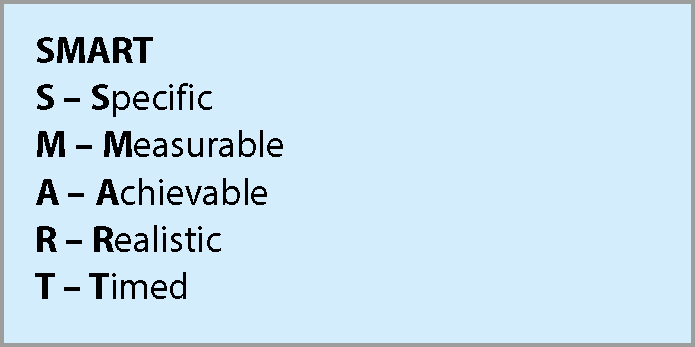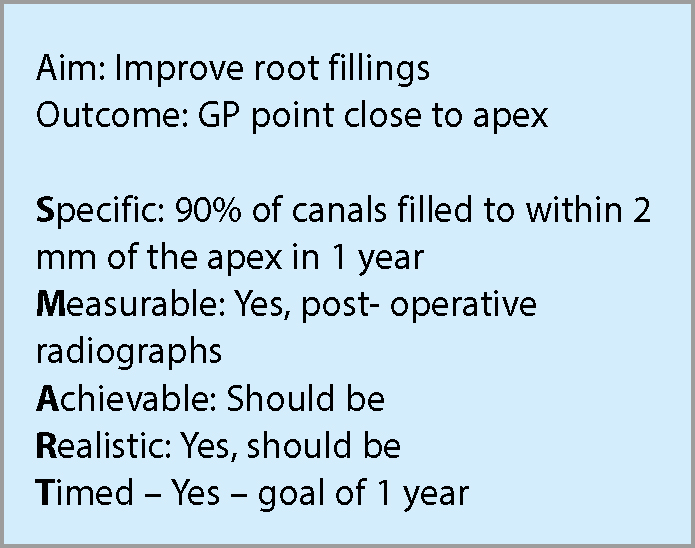Abstract
Appraisal has been a key component of staff management of most organizations for more than a decade. This article explores the principles, benefits and stages for effective appraisal in primary dental care.
From Volume 40, Issue 8, October 2013 | Pages 679-682
Appraisal has been a key component of staff management of most organizations for more than a decade. This article explores the principles, benefits and stages for effective appraisal in primary dental care.

In 2011, the General Dental Council commissioned a report into the ‘Impact of Dental CPD’.1 The report reviewed the published research literature on the subject. The authors noted that planning, self-directed learning and reflection was important in Continuing Professional Development (CPD) and that Personal Development Planning and reflection assist clinicians in taking part in appropriate CPD. Personal Development Planning has been defined as ‘a structured and supported process undertaken by an individual to reflect upon their own learning, performance and/or achievement and to plan for their personal, educational and career development’ by the Higher Education Academy.2 In the autumn of 2012, the GDC published a consultation document on CPD for assurance and fitness to practise3 and this influenced their thinking on reforms to Continuing Professional Development (CPD). In the document they noted some key findings (Table 1). They suggested that CPD should address the four domains of Clinical, Communication, Management & Leadership and Professionalism and that CPD should be based on a process of:
|
|
The report noted that, based on previous research,4 27% of registrants had never had an appraisal. The GDC published a report in November 2012, commissioned from the Picker Institute Europe,5 recommending the use of carefully designed, appraisal-based revalidation in combination with audit, CPD, etc.
It seems likely that revalidation will include some form of appraisal and this article explores the definition of benefits, principles, structure and format of effective appraisal. As indicated by the Picker Institute, appropriate training, as well as practice, is needed to make appraisal effective.
The NHS Revalidation Support Team in its Medical Appraisal Guide gives the definition: ‘Medical appraisal is a process of facilitated self-review supported by information gathered from the full scope of a doctor's work’.6
Appraisal allows an opportunity to review progress in attaining personal goals and to explore issues concerning how well the plans have been met. The use of a colleague or trained appraiser allows the opportunity to explain the rationale for actions, assess how successful these actions are and provide a gentle challenge on how to improve in the future. If conducted in a constructive, supportive way, appraisal can motivate and inspire the appraisee to achieve great results and goals for both him/herself and the organization in which he/she works.
Appraisal is fundamentally a review of activities an individual or his/her organization/practice has agreed to carry out to analyse the knowledge, skills or behaviours in the past and to define them for the future. It is likely to include a review of a person's role in an organization and any goals set and agreed for the period since the last appraisal.
The appraisal may include task-based targets, Key Performance Indicators (KPI), or could be more focused on personal development. Some organizations separate performance review, eg review of how an employee has performed against his/her job description and key targets, from personal development review/appraisal, as one is more concerned with performance management and the latter with individual performance.
The principle of an appraisal for revalidation is to support the appraisee, review his/her evidence of how to manage CPD, and to show how he/she practises to current standards and focuses on continuous improvement.
Effective appraisals depend on both appraiser and appraisee preparing for the event. This normally involves gathering data that will be discussed and the appraisee writing a summary. The use of proforma appraisal forms may help as they can be divided into sections which prompt the appraisee to reflect on what has happened in the period since the last review and write down plans and aspirations for the next period and give the appraiser space to write in points he/she wishes to discuss or review. Ideally, the appraisee should complete his/her sections and then pass them to the appraiser to complete the relevant sections and return to the appraisee in advance, so there are no areas where the appraisee is not given prior notice of possible discussion.
The appraisee or appraiser may decide that evidence needs to be provided to support the discussion as to how well an appraisee undertakes his/her role and the evidence may assist in identifying areas for development. Table 2 shows types of additional evidence that could be used.
|
|
Individuals respond best to being asked questions and formulating their own actions and so an effective appraiser should ask questions which stimulate thought and action from the appraisee.
Annual appraisal of professional development is concerned with the individual and his/her activity. It may be appropriate to focus it on last year's Personal Development Plan (PDP) and include a review of next year's PDP. These may be linked into more long-term plans for the individual and the organization/practice. A well-structured PDP identifies what someone wishes to learn or do better. It describes how he/she will go about this and be able to identify when he/she has achieved it. More information on PDPs was given in Dental Update in 2011.7
Ideally, the appraisee should write down the points for discussion under stages 1 and 3 in advance and the appraiser should write down any points he/she wishes to discuss under stages 2 and 4, and the appraisee can then be given this information. In this way, it is possible to minimize any shocks and surprises which might de-rail the appraisal meeting.
This model of appraisal is based on the appraisee leading the process, whilst allowing the appraiser to add points he/she feels need discussion. Allowing both parties to identify these points in advance in writing gets them out in the open and so gives openness and clarity to the appraisal meeting and minimizes the chances for shocks, surprises and possible confrontation that might stop the appraisal process being effective and constructive.
The main role of the appraiser in this process is to listen to the appraisee, ask questions to clarify points made and determine how these will benefit the appraisee or the organization, and then reach an agreed set of actions for the next year. Often people fail to achieve the things they wish because they feel the targets are either too difficult, time consuming or will bring little benefit. A well-conducted appraisal, where the appraiser uses effective questioning and coaching techniques, helps the appraisee to overcome a barrier to success and identify what support the organization can give him/her in achieving these goals.
Successful appraisal is likely to occur if the appraiser gives appropriate feedback and asks appropriate questions to clarify points and assist the appraisee in identifying solutions to problems. The more an appraiser uses questions and minimizes the use of statements, the more likely it will be that the process will be successful.
The choice of appraiser and his/her skill levels can have a major effect on the outcome and robustness of the whole process. Appraisers can be either internal (colleagues, employer) to an organization or external. Most organizations tend to use internal appraisers and these are often line managers, or could be practice managers or owners. Whilst this can be cost-effective, it does run the risk of bias and personal opinions creeping in and so the process loses objectivity. External appraisers tend to add cost and may mean that they are not familiar with organization/practice strategies and development needs. Probably most critical to the process is the skill level of the appraiser. It is his/her skill and attitude that is likely to set the temperature of the appraisal and so have a significant effect on the outcome of the process and determine how much value the appraisee gets from the process. If the appraiser approaches the appraisal in an open way, asking questions, seeking clarity and rarely offering personal views, then the process is more likely to be effective. The skills required from an effective appraiser are those required to be an effective coach or mentor, assisting the appraisee to explore, clarify and agree actions for the next period.
One of the key roles of an appraiser may be to assist the appraisee in developing appropriate goals for the next period. Having clarity about these actions and goals is more likely to lead to the attainment of them. Setting goals using the SMART acronym can assist in this (Figure 1). For example: Aim: To improve root fillings; Desired outcome: GP point close to apex. This is still rather vague. However, by applying the SMART approach, the process is refined (Figure 2).


Setting SMART goals is only part of the process as a discussion may be needed on how to achieve such goals. Does the person need to attend a practical course to find out how to improve the outcome or are they happy to study it in books, online and then practise on extracted teeth? Once the updating of knowledge and skills has taken place, there is a need to gather evidence to discover how well the outcome is being achieved in terms of patient satisfaction. This is most likely to be by a structured audit. The role in these processes of the appraiser may be to ask the appraisee how he/she hopes to achieve specified goals. Some appraisees may have all the stages worked out and be able to achieve them, whilst others may need assistance in the form of focused questions to assist in working out the stages.
In conclusion, a carefully planned and executed appraisal can be motivating and constructive, assisting the appraisee in identifying areas for development with agreed support from the organization as a whole. Hopefully, the outcome should result in improved performance, job satisfaction and better care for patients.